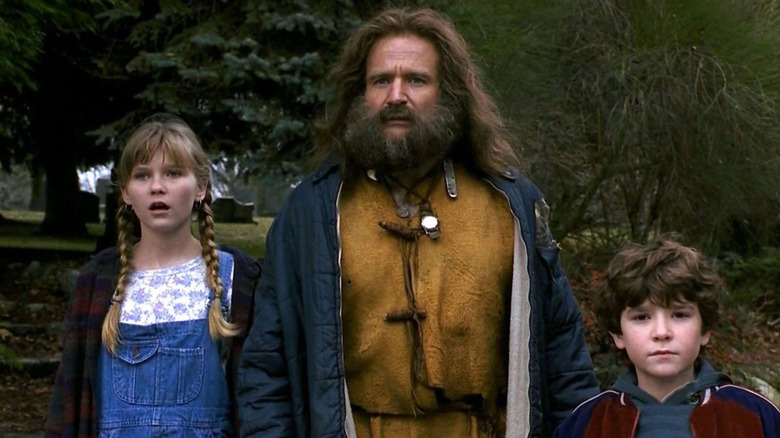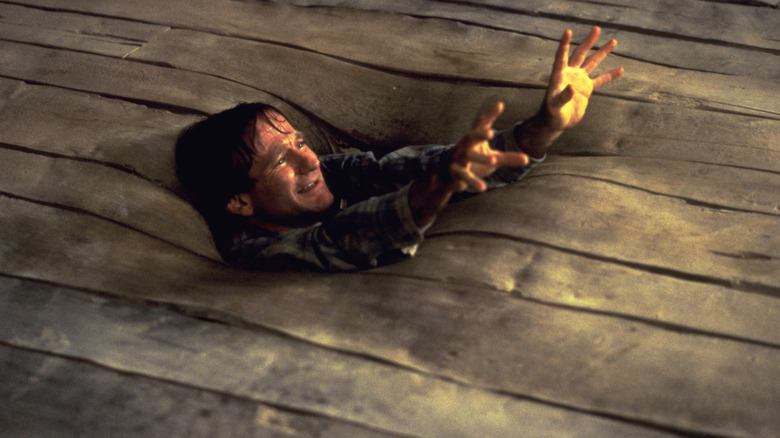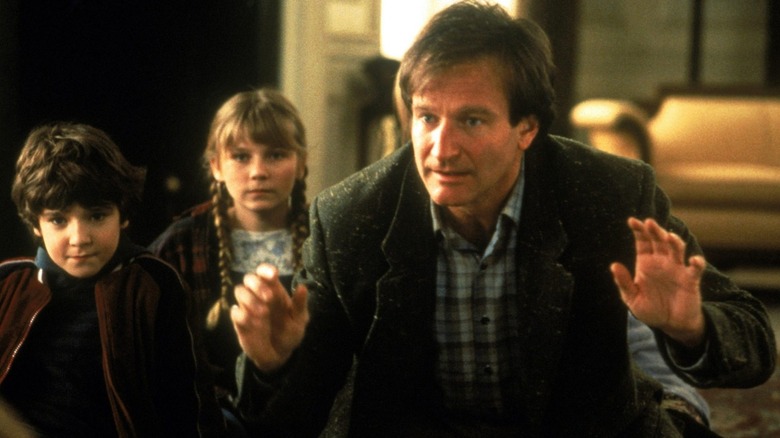Jumanji Scrapped A Wild Sequel Idea That Would've Unleashed Chaos At The White House
The original picture book "Jumanji," written and illustrated by Chris Van Allsburg, was rather simple. A pair of kids find a mysterious boxed board game at a park and take it home to play it. The game, "Jumanji," is a jungle-themed adventure that warns players not to begin unless they intend to finish. They find that playing the game manifests jungle animals and bad weather in their home, and soon the house has been trashed by rhinos and monsoons. When they finish the game, all the damage is magically undone. "Jumanji" was published in 1981, and was a library standard for a decade.
In 1995, Joe Johnston directed a feature film adaptation that strayed dramatically from the picture book. Using then-cutting-edge CGI, "Jumanji" was about a child who was sucked into an alternate jungle dimension in 1969, and left there for decades because his "Jumanji" partner abandoned the game. In the present, two new kids play the game and summon the missing child, now an adult played by Robin Williams. The three of them must track down Williams' old board game partner and finish the game to undo all the magical shenanigans. A child turns into a monkey.
"Jumanji" was a massive hit among young audiences, and remains beloved to those who were nine or ten in 1995.
A sequel didn't arrive in theaters until 2017 with the release of "Jumanji: Welcome to the Jungle." That film altered the premise sightly, changing the board game into a video game. Van Allsburg, however, was recently interviewed by SyFy Wire, to whoom he revealed that there was a plan back in 1995 to make an immediate sequel with the same cast and the same board game ... but set in the White House.
Sadly, this film never came to be.
Jumanji in the White House
At the end of Johnston's film, the magical board game is thrown into the ocean, only to find its way onto a beach somewhere in France. Two French kids find the game, and presumably the adventure repeats itself for them. The idea of "Jumanji: The White House" was to be extrapolated from that ending. Van Allsburg recalled how the Jumanji board game was to make its way from that French beach back to the White House in America. It turns out that the beach was Normandy Beach. Van Allsburg said:
"I don't know if there was a single writer involved, but [they] decided that that event happened in Normandy, that the game had floated across the ocean. [...] The game ends up in an antique shop in Normandy and stays there for some period of time."
And who should be visiting Normandy Beach to celebrate the anniversary of D-Day, but the President of the United States? And, by coincidence, he just happens to be looking for something uniquely French to buy for his kids, presumably between eight and 12. The "Jumanji" board game would be purchased and brought to Washington, DC. Van Allsburg continued:
"He's promised his kids to bring back a souvenir from his trip. [...] And so, the presidential entourage stops at this little antique shop in Normandy and the President goes in and finds this old board game, 'Jumanji.' He packs it up and he takes it back to Washington, DC and then all the mayhem that the game can generate is generated in the White House and the halls of Congress ... They had some crazy stuff. I think there was a gorilla that climbs the Washington Monument in an homage to 'King Kong.'"
Awsome? Or bad?
Opting for a 'Jumanji in Space' sequel
Van Allsburg, it should be noted, really, really hated this idea. He shared other ideas that the producers of "Jumanji: The White House" had, and he understood that they were only being included as an excuse to show off the new special effects technology that Sony had access to. Evidently, there was also a scene wherein the magical Jumanji animals, unleashed from the board game, were cut in half by the presidential helicopter. Because they are magical, however, "they were able to reassemble themselves into different parts of an animal," Van Allsburg said. "It was just a really lame excuse to see what some CGI artist could do. Totally idiotic."
It's worth noting that the 1995 "Jumanji" featured no real animals, opting to use CGI effects to bring lions and chimpanzees to life. It was an SFX bonanza as much as an adventure. Van Allsburg didn't like that "Jumanji 2" was going to be more of the same. He recalled: "One of the producers said to me, 'The only thing that would keep them from making this is a better idea.'" So he had to come up with a better idea himself. In 2002, he published a new picture book called "Zathura," which was essentially a sci-fi re-working of "Jumanji." The new book featured the same type of magical board game, but this time manifesting robots and astronauts instead of jungle animals.
"Zathura" was adapted into a film in 2005 by Jon Favreau. Van Allsburg effectively sidestepped "Jumanji: The White House" and its bizarre bifurcated animals. Two more "Jumanji" sequels came in 2017 and in 2019, and another is currently in the works.


